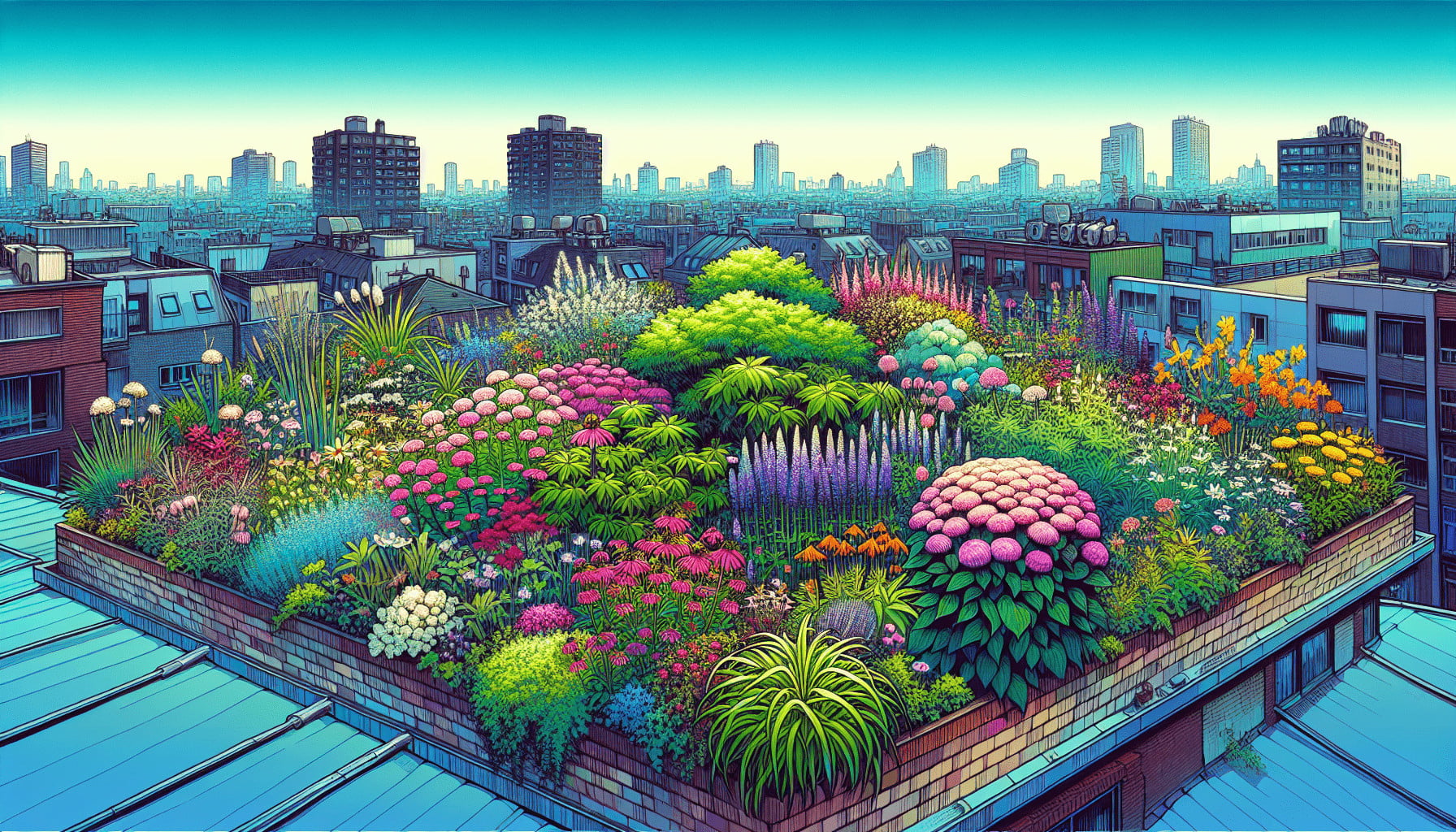Dive into the world of rooftop gardening with our guide to the top 10 perennial plants that will keep your urban oasis vibrant and thriving all year long. You’ll discover a variety of hardy, beautiful plants that are well-suited for rooftop environments, offering both ease of care and stunning visuals through every season.
A rooftop garden doesn’t just add to your home’s aesthetic appeal; it provides a slice of nature’s tranquility in an urban environment. If you’ve been contemplating what to plant, look no further. This guide will delve into the “Top 10 Perennial Plants for a Beautiful Year-Round Rooftop Garden,” ensuring your rooftop remains lush and vibrant regardless of the season.

Why Choose Perennial Plants for Your Rooftop Garden?
Perennial plants are an excellent choice for rooftop gardens because they regrow every year without needing to be replanted. This saves you both time and money in the long run. Additionally, perennial plants typically require less maintenance than annuals, making them ideal for high-up, hard-to-reach spaces like rooftops.
Perennials are also incredibly versatile, coming in various shapes, sizes, and colors. From foliage to flowers, you’ll find perennials that suit every aesthetic preference and environmental condition. So, let’s explore the top ten perennial plants that will keep your rooftop garden stunning throughout the year.
1. Lavender (Lavandula)
Why Lavender?
Lavender is a versatile and hardy perennial with silvery foliage and fragrant purple blooms. It’s known for its drought tolerance, making it perfect for rooftop gardens where water availability can sometimes be an issue.
How to Care for Lavender
Lavender thrives in well-drained soil and full sunlight. Water it sparingly, especially in winter, to prevent root rot. Prune it annually to maintain a compact shape and remove spent flowers to encourage more blooms.
Benefits
- Aesthetics: Adds a Mediterranean touch.
- Fragrance: Pleasant aroma repels pests.
- Uses: Can be used in culinary dishes and for medicinal purposes.
2. Daylilies (Hemerocallis)
Why Daylilies?
Daylilies are almost fool-proof perennials that can adapt to various climates and soil types. Their trumpet-shaped flowers come in numerous colors, offering vibrant bursts to your rooftop garden throughout summer.
How to Care for Daylilies
Daylilies need at least six hours of direct sunlight daily. Plant them in well-drained soil enriched with organic matter. Water them regularly during the growing season but cut back in the winter.
Benefits
- Low Maintenance: Requires minimal care.
- Durability: Can withstand urban pollution.
- Color Variety: Offers an array of colors and patterns.
3. Hosta (Hosta spp.)
Why Hosta?
Hostas are shade-loving perennials boasting diverse foliage colors and textures. They’re perfect for adding some greenery to those shadier spots on your rooftop garden.
How to Care for Hostas
Hostas do well in partial to full shade. They prefer moist, well-draining soil. Mulch around the base to retain moisture and remove dead leaves regularly to prevent disease.
Benefits
- Foliage: Diverse leaves add texture.
- Shade Tolerance: Perfect for less sunny spots.
- Easy to Grow: Minimal maintenance required.
4. Sedum (Sedum spp.)
Why Sedum?
Sedum is a succulent-type perennial known for its drought resistance and ability to thrive in tough conditions. This quality makes it an excellent candidate for rooftop gardens.
How to Care for Sedum
Sedum needs full sunlight and well-drained soil. Overwatering can be lethal, so it’s best to water sparingly. Sedum is virtually pest-free and requires little pruning.
Benefits
- Drought Tolerance: Thrives with minimal water.
- Pest Resistance: Naturally repels pests.
- Ground Cover: Works well as a ground cover plant.
5. Russian Sage (Perovskia atriplicifolia)
Why Russian Sage?
Russian Sage is a long-blooming perennial that produces spires of lavender-blue flowers. It thrives in hot, dry conditions, making it ideal for rooftop settings.
How to Care for Russian Sage
Russian Sage flourishes in full sunlight and well-drained soil. It requires minimal watering once established and needs annual pruning to maintain shape and remove old growth.
Benefits
- Low Maintenance: Minimal watering and pruning required.
- Long Blooming: Flowers from mid-summer to fall.
- Drought Resistant: Perfect for hot, dry rooftops.

6. Ornamental Grasses (Various Species)
Why Ornamental Grasses?
Ornamental grasses bring a touch of elegance and movement to your rooftop garden. They’re generally low maintenance and drought-tolerant, making them perfect for urban settings.
How to Care for Ornamental Grasses
Most ornamental grasses prefer full sunlight and well-drained soil. They need occasional watering during dry spells and should be pruned back annually to promote new growth.
Benefits
- Aesthetic Appeal: Adds texture and movement.
- Low Maintenance: Requires minimal care.
- Versatile: Wide range of heights and colors available.
7. Coneflower (Echinacea)
Why Coneflower?
Coneflowers are tough, drought-resistant perennials with large, daisy-like blooms. They attract pollinators like bees and butterflies, adding life to your rooftop garden.
How to Care for Coneflower
Coneflowers need full sun and well-drained soil. Water them regularly during their first growing season, then they can typically withstand dry spells. Cut back dead stems in winter to promote new growth in spring.
Benefits
- Pollinator Friendly: Attracts bees and butterflies.
- Low Maintenance: Easy to care for.
- Long Blooming: Flowers from summer to fall.
8. Creeping Thyme (Thymus serpyllum)
Why Creeping Thyme?
Creeping Thyme is a low-growing, aromatic perennial that forms a dense mat, making it perfect for ground cover on a rooftop garden. It’s also drought-resistant and hardy.
How to Care for Creeping Thyme
Creeping Thyme needs full sunlight and well-drained soil. It requires minimal watering once established and thrives in lean, rocky soils. Prune it lightly after flowering to maintain its shape.
Benefits
- Ground Cover: Excellent as a ground cover plant.
- Fragrant: Adds aroma to your garden.
- Drought Resistant: Very hardy and low maintenance.
9. Coreopsis (Coreopsis spp.)
Why Coreopsis?
Coreopsis, also known as tickseed, is a cheerful, daisy-like perennial that comes in various bright colors. It’s easy to grow and withstands drought and neglect.
How to Care for Coreopsis
Coreopsis prefers full sun and well-drained soil. Water regularly during the growing season but cut back in winter. Deadhead spent flowers to promote continuous blooming.
Benefits
- Vibrant Blooms: Adds bright colors.
- Low Maintenance: Easy to grow.
- Weather Resistant: Withstands drought and neglect.
10. Yarrow (Achillea millefolium)
Why Yarrow?
Yarrow is a hardy perennial known for its feathery foliage and clusters of tiny, colorful flowers. It’s exceptionally drought-tolerant and can thrive in various conditions, making it perfect for a rooftop garden.
How to Care for Yarrow
Yarrow needs full sun and well-drained soil. Once established, it requires minimal watering. Deadhead spent flowers to encourage new blooms and cut back old growth in winter.
Benefits
- Hardy: Tolerates drought and poor soil.
- Pollinator Friendly: Attracts bees and butterflies.
- Low Maintenance: Requires minimal care.
Comparing the Top 10 Perennials
Let’s compare some critical aspects of these top ten perennial plants to assist you in making the best choice for your rooftop garden.
| Plant Name | Sunlight Requirement | Watering Needs | Maintenance Level | Key Benefits |
|---|---|---|---|---|
| Lavender | Full Sun | Low | Medium | Fragrance, Drought Tolerant |
| Daylilies | Full Sun | Medium | Low | Color Variety, Durable |
| Hosta | Shade | Medium | Low | Foliage Diversity |
| Sedum | Full Sun | Low | Low | Drought Tolerant, Pest Resistant |
| Russian Sage | Full Sun | Low | Low | Long Blooming, Drought Resistant |
| Ornamental Grasses | Full Sun | Medium | Low | Aesthetic Appeal |
| Coneflower | Full Sun | Medium | Low | Pollinator Friendly |
| Creeping Thyme | Full Sun | Low | Low | Ground Cover, Fragrant |
| Coreopsis | Full Sun | Medium | Low | Vibrant Blooms |
| Yarrow | Full Sun | Low | Low | Hardy, Pollinator Friendly |
General Tips for Rooftop Gardening
Having a beautiful rooftop garden involves more than just picking the right plants. Here are some general tips to make your rooftop garden thrive.
Soil and Containers
Use high-quality, well-draining soil. Consider raised beds or sturdy pots that can withstand wind. Ensure your containers have adequate drainage holes to prevent waterlog.
Watering
Rooftop gardens can dry out quickly due to wind and sun exposure. Drip irrigation systems are effective for consistent moisture. Early morning or late evening watering reduces evaporation.
Pest Control
Natural pest repellents like neem oil can be effective. Also, choose pest-resistant plants like lavender and sedum to naturally minimize pest issues.
Wind and Sun Protection
Install windbreaks like lattice panels or plant tall grasses to shield more delicate plants. Similarly, consider shade cloths if your rooftop gets overly sunny.
Winter Care
For perennials to survive winter, insulate containers with bubble wrap or move them to a sheltered location. Mulch around the base of plants to protect root systems from freezing temperatures.
Conclusion
Creating a rooftop garden can be an incredibly rewarding experience, providing a tranquil escape in an urban environment. Perennial plants are a superb choice for this setting due to their hardiness, low maintenance, and year-round beauty. Whether you’re drawn to the fragrant blooms of lavender, the robust charm of daylilies, or the hardy nature of yarrow, there’s a perennial here to suit every rooftop oasis.
With these top 10 perennial plants, your rooftop garden will not only be a sight to behold but also an eco-friendly and resilient green space that brings joy and serenity throughout the year. So go ahead and transform that rooftop into your personal paradise; the sky’s the limit!
